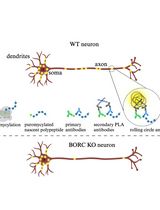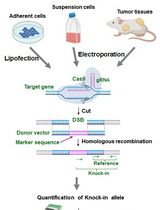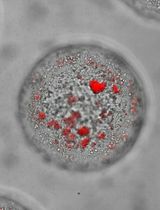- EN - English
- CN - 中文
Measurement of Bone Metastatic Tumor Growth by a Tibial Tumorigenesis Assay
用胫骨肿瘤发生法测定骨转移瘤的生长
发布: 2021年11月20日第11卷第22期 DOI: 10.21769/BioProtoc.4231 浏览次数: 4423
评审: Luis Alberto Sánchez VargasVikash VermaMarieta Ruseva
Abstract
Bone metastasis is a frequent and lethal complication of many cancer types (i.e., prostate cancer, breast cancer, and multiple myeloma), and a cure for bone metastasis remains elusive. To recapitulate the process of bone metastasis and understand how cancer cells metastasize to bone, intracardiac injection and intracaudal arterial animal models were developed. The intratibial injection animal model was established to investigate the communication between cancer cells and the bone microenvironment and to mimic the setting of prostate cancer patients with bone metastasis. Given that detailed protocols of intratibial injection and its quantitative analysis are still insufficient, in this protocol, we provide hands-on procedures for how to prepare cells, perform the tibial injection, monitor tibial tumor growth, and quantitatively evaluate the tibial tumors in pathological samples. This manuscript provides a ready-to-use experimental protocol for investigating cancer cell behaviors in bone and developing novel therapeutic strategies for bone metastatic cancer patients.
Keywords: Bone metastasis (骨转移)Background
Bone metastasis is the most frequent metastasis for many cancer types, especially for those arising from prostate (90%), breast (70%), multiple myeloma (90%), lung (40%), and kidney (40%) (Coleman, 2006). The median survival of patients with bone metastasis ranges from approximately one year for lung cancer to 3-5 years for prostate cancer, breast cancer, and multiple myeloma (Campbell et al., 2012). Bone metastases often require radiotherapy and lead to bone pain, hypercalcemia, pathologic fracture, and spinal cord or nerve root compression (Coleman, 2006). Bone metastases also develop resistance to chemotherapy, as docetaxel-treated prostate cancer patients with bone metastasis still have poor prognoses (Coleman et al., 2020). Therefore, effective therapeutic strategies are still urgently needed for bone metastatic cancer patients.
Bone metastases can be classified as osteolytic or osteoclastic types according to their predominant characteristics in radiographic images. Although lysis or sclerosis may appear to predominate in some types of bone metastases, osteoclastic and osteoblastic activities are usually simultaneously involved in the formation of bone metastatic lesions. The outgrowth of cancer cells in the bone microenvironment is a process in which cancer cells communicate with osteoclasts and osteoblasts frequently via paracrine factors and receptors on their cell surfaces. Therefore, the behaviors of cancer cells in bone metastasis are distinct from those in primary tumors, thus potentially requiring different therapeutic methods.
Diverse in vivo animal models have been established to study bone metastasis. Intracardiac injection has been utilized as the gold standard to develop bone metastasis by injecting cancer cells into the left ventricle in mice, with a goal of recapitulating the bone metastasis process, including cancer cell survival in the bloodstream, extravasation, cancer cell arrest in bone, and bone metastatic tumor growth (James et al., 2015). Similarly, intracaudal arterial injection was established to provide an easy-to-use model with higher efficiency of bone metastasis (Kuchimaru et al., 2018). However, the intratibial injection model is used to mimic the scenario when cancer cells have metastasized to the bone, thus providing a better focus on the crosstalk between cancer cells and the bone microenvironment. Herein, we will focus on tibial tumorigenesis by using the intratibial injection model to mimic the setting of cancer patients who have developed bone metastasis.
In this protocol, we take the prostate cancer cell line PC-3 as an example, describe the hands-on procedures of cell preparation, intratibial injection, monitoring tibial tumor growth, and post tissue collection analyses, highlight the critical steps in cell preparation and intratibial injection, and detail how to quantitatively analyze the tibial tumors in histological samples.
Materials and Reagents
Nude mice (The Jackson Laboratory, catalog number: 002019)
NOD SCID mice (The Jackson Laboratory, catalog number: 001303)
Povidone Iodine Prep Pads (DYNAREX, catalog number: 1108)
Sterile Alcohol Prep Pads (DYNAREX, catalog number: 1116)
27G ½’’ syringe (BD, catalog number: 305620)
40 µm Cell Strainer (Fisher Scientific, catalog number: 087711)
PC-3 cells (ATCC, catalog number: CRL-1435)
Ham's F-12K (Kaighn's) Medium (ThermoFisher, catalog number: 21127022)
FBS (Sigma, catalog number: F2442)
0.05% trypsin-EDTA (ThermoFisher, catalog number: 25300054)
0.4% trypan blue solution (Sigma, catalog number: T8145)
PBS (Sigma, catalog number: 806552-1L)
Isoflurane Inhalation Anesthetic (Southern Anesthesia & Surgical, catalog number: PIR001325)
Human Kallikrein 3/PSA Quantikine ELISA Kit (R&D system, catalog number: DKK300)
14% EDTA (pH 7.4) (American Research Product, catalog number: BM-150A)
10% neutral-buffered formalin (Sigma, catalog number: HT501128)
100% Ethanol (KOPTEC, catalog number: 89426-252)
Hematoxylin (Electron Microscopy Sciences, catalog number: 26043-05)
Eosin Y-solution (Millipore Sigma, catalog number: 102439)
Permount (Fisher Scientific, catalog number: SP15100)
Xylene (Fisher Chemical, catalog number: X54)
Immu-Mount (Epredia, catalog number: 9990402)
Sodium acetate anhydrous (Sigma, catalog number: S-2889)
L-(+) tartaric acid (Sigma, catalog number: T-6521)
Fast Red Violet LB salt (Sigma, catalog number: F-3381)
Napthol AS-MX phosphate (Sigma, catalog number: N-4875)
Basic Staining Buffer for TRAP staining (see Recipes)
TRAP Staining Solution (see Recipes)
10% EDTA (see Recipes)
Equipment
Refrigerated centrifuge (Eppendorf, model: 5810R)
Gas Anesthesia System (PerkinElmer, model: XGI-8)
Heating pad (Sunbeam Products, catalog number: 2139885)
IVIS® Spectrum Imaging System (PerkinElmer)
MX-20 X-ray system (Faxitron [Tucson, Arizona])
-80°C freezer (Fisher, catalog number: TSU600ARAK)
Embedding Center (Leica, catalog number: EG1160)
Rotary Microtome (Leica, catalog number: RM2135)
NanoZoomer Whole Slide Scanner (Olympus, Hamamatsu)
Software
NDP.view2 (HAMAMATSU, https://www.hamamatsu.com/us/en/product/type/U12388-01/index.html)
Living Image software (PerkinElmer, https://www.perkinelmer.com.cn/product/li-software-for-lumina-1-seat-add-on-128110)
Procedure
文章信息
版权信息
© 2021 The Authors; exclusive licensee Bio-protocol LLC.
如何引用
Zhang, B., Li, X., Qian, W. P., Wu, D. and Dong, J. T. (2021). Measurement of Bone Metastatic Tumor Growth by a Tibial Tumorigenesis Assay. Bio-protocol 11(22): e4231. DOI: 10.21769/BioProtoc.4231.
分类
癌症生物学 > 侵袭和转移 > 动物模型
癌症生物学 > 通用技术 > 动物模型
生物科学 > 生物技术
您对这篇实验方法有问题吗?
在此处发布您的问题,我们将邀请本文作者来回答。同时,我们会将您的问题发布到Bio-protocol Exchange,以便寻求社区成员的帮助。
Share
Bluesky
X
Copy link












